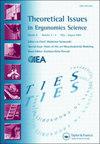The Next Generation of Fatigue Prediction Models: Evaluating Current Trends in Biomathematical Modelling for Safety Optimization
IF 1.4
Q4 ERGONOMICS
引用次数: 3
Abstract
Biomathematical models (BMMs) are parametric models that quantitatively predict fatigue and are routinely implemented in fatigue risk management systems in increasingly diverse workplaces. There have been consistent calls for an improved "next generation” of BMMs that provide more accurate and targeted predictions of human fatigue. This review examines the core characteristics of next-generation advancements in BMMs, including tailoring with field data, individual-level parameter tuning and real-time fatigue prediction, extensions to account for additional factors that influence fatigue, and emerging nonparametric methodologies that may augment or provide alternatives to BMMs. Examination of past literature and quantitative examples suggests there are notable challenges to advancing BMMs beyond their current applications. Adoption of multi-model frameworks, including quantitative joint modelling and machine learning, was identified as crucial to next-generation models. We close with general recommendations for researchers and model developers, including focusing research efforts on understanding the cognitive dynamics underpinning fatigue-related vigilance decrements, applying emerging dynamic modelling methods to fatigue data from field settings, and improving the adoption of open scientific practices in fatigue research.下一代疲劳预测模型:评估安全优化生物数学建模的当前趋势
生物数学模型(bmm)是定量预测疲劳的参数模型,在日益多样化的工作场所的疲劳风险管理系统中得到了常规应用。人们一直呼吁改进“下一代”的bmm,以提供更准确、更有针对性的人体疲劳预测。这篇综述探讨了下一代bmm技术进步的核心特征,包括根据现场数据进行定制、个人层面的参数调整和实时疲劳预测、扩展以考虑影响疲劳的其他因素,以及新兴的非参数方法,这些方法可能会增强或提供bmm的替代方案。对过去文献和定量例子的研究表明,在目前的应用之外,推进bmm存在显著的挑战。采用多模型框架,包括定量联合建模和机器学习,被认为是下一代模型的关键。最后,我们对研究人员和模型开发人员提出了一般性建议,包括将研究重点放在理解支撑疲劳相关警觉性下降的认知动力学上,将新兴的动态建模方法应用于现场设置的疲劳数据,以及在疲劳研究中改进开放式科学实践的采用。
本文章由计算机程序翻译,如有差异,请以英文原文为准。
求助全文
约1分钟内获得全文
求助全文

 求助内容:
求助内容: 应助结果提醒方式:
应助结果提醒方式:


